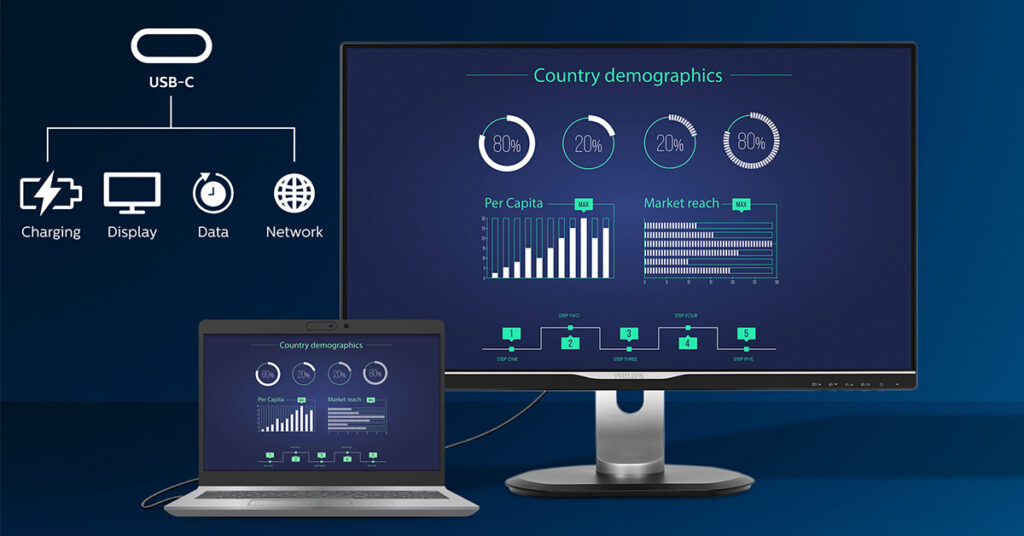What is a USB-C Docking Station with Power Delivery?

When it comes to modern office work, cable clutter is a huge concern. Philips’ power delivery feature is a great way to make your office look cleaner and more organized, and it comes in different options (such as USB-C, hubs, docking stations and stations with RJ45). Not only will this reduce the clutter, but it can also reduce stress and frustration associated with setting up your workstation.
Philips monitors offer different USB-C options based on the specific needs of their users. The Philips 34B1U5600CH is designed to facilitate every task, delivering amazing picture and image quality to please even the most demanding professional with its VA panel and CrystalClear Quad HD. Connectivity and multi-tasking are prioritized, thanks to innovative technology such as one-cable-docking USB Type-C, which enables simultaneous high-speed data transfer, networking, and notebook charging, or the MultiClient Integrated KVM switch, which allows users to control two separate PCs with a single monitor-keyboard-mouse set-up and gives them the ability to toggle between sources at the push of a button. DisplayPort-out is another feature that simplifies the workday by allowing users to daisy chain their workstation. For more information, check out the product here.
Similarly, Philips monitors also offer integrated USB-C hubs or Docking stations, which are not synonyms. Both are specifically designed to connect multiple displays and peripherals, but USB docking stations are generally more powerful than hubs since they feature more ports than USB-C hubs and more connectivity options. Here you can find more information on our USB-C Docking Station solutions; click here.
The Philips 45B1U6900CH is equipped with a large, 44.5-inch (113 cm diagonal) screen with 5120 x 1440 resolution and several other features that are designed to aid professionals’ multitasking, such as: a 32:9 SuperWide screen, and a curvature of 1500R with viewing angles of 178/178 degrees and a 5 MP webcam with Windows Hello™. This monitor offers another notable feature that will improve workspaces: the USB-C docking with RJ45. With this docking system, professionals can connect to the network with RJ45, set up power delivery to their connected devices, experience high-resolution video output, and connect an external device for high-speed data transfer. For more information, check out the product here.
Let’s take a closer look on USB-C and Power Delivery!
1. What is the difference between USB-C and USB-C Power Delivery?
USB-C is a type of connector that is used to connect a variety of different types of devices, including computers, phones, monitors, and other peripherals. USB-C Power Delivery is a power delivery specification that allows USB-C devices to deliver up to 90 or 96 watts of power over a single cable. This allows for fast charging of devices while in use, even for larger devices such as laptops that can be charged through the USB-C hub of your monitor. For example, the beforementioned Philips 34B1U5600CH delivers up to 100 watts of power for charging your laptop while in use from the monitor, with only one cable. For more information, check out the product here.
2. Do docking stations come with power supply?
To an extent. Many USB-C docking stations do come with power supply technology, which is essential for professionals working with large set-ups or with many peripherals, so to reduce clutter. However, it is always best to double check. For example, the Philips 45B1U6900CH is equipped with a USB-C docking station with PD and RJ45: a real powerhouse for the most demanding users! For more information, check out the product here.
2.1 Do all USB-C support power delivery?
No, not all USB-C ports support power delivery. Power delivery is an optional feature of the USB-C standard, so some USB-C ports may not support it. To be sure, please check the specifications of the port.
2.2 Does USB-C 3.2 support Power Delivery?
It depends. But to avoid confusion we should take a step back: the USB Type C standard defines only the physical connector in use (slim, type C), while the USB 3.2 standard applies only to the electrical signal. Similarly, USB Power Delivery specifications provide information regarding the implementation of higher levels of power delivery available through USB Type C connectors. So, there surely are USB-C 3.2 that support Power Delivery, but just check beforehand.
3. What is the difference between charging and Power Delivery?
The terms “charging” and “Power Delivery” are often used interchangeably, but they are different concepts. Charging refers to the process of providing electrical energy to a device, such as a laptop, to charge its battery. Power delivery, on the other hand, is a technology that enables higher speed, greater efficiency, and more reliable power delivery to devices.
The main differences are in the speed at which power is delivered, and efficiency. For example, most laptop chargers have a maximum power output of 45 watts, which means it may take several hours to fully charge a laptop. Power Delivery, on the other hand, can deliver up to 90 watts of power, allowing it to charge a laptop much faster. Charging is not very efficient, as much of the power is lost as heat. Power Delivery, however, is much more efficient, as it uses a sophisticated power management system to ensure that the device is receiving the optimal amount of power. This ensures that the device is charged quickly and efficiently, without wasting energy.
3.1 Is Thunderbolt and USB-C same?
Thunderbolt and USB-C cables and ports are not the same, although they do look almost identical and are mostly compatible. However, for full compatibility, it is always best to plug a Thunderbolt device into a Thunderbolt computer port.
4. Do all USB-C cables have the same power delivery?
Not all USB-C cables are the same, offering the same features. Since each USB-C cable is different, they also have different power deliveries. Generally, they can have different voltage ratings, be passive or active, support only USB 2.0 up to USB 4, support alternate models.
